House of Habsburg
![]()
This article is about the noble family, for other meanings see Habsburg (disambiguation).
The Habsburgs (also House of Habsburg, House of Austria and Casa de Austria) are a princely dynasty named after their ancestral castle in what is now the Swiss canton of Aargau. From the late Middle Ages onwards, they rose to become the most powerful dynasty in Europe, alongside - and in competition with - the Capetians, for half a millennium, and also ruled a colonial empire via the kingdoms of Spain and Portugal.
The designation "House of Austria" was transferred from the country, the Duchy of Austria to the Habsburgs in the 14th century. This designation then transferred to the lands ruled by the Habsburgs. The upgrading of the Austrian duchy to an archduchy was accompanied by the designation of the ruling family as the Archhouse. It was the only dynasty in the world to use the title archduke (created by itself).
The Habsburgs initially had major landholdings in Upper Alsace between Basel and Strasbourg. In October 1273, Rudolf I became the first Habsburg to be elected king of the Holy Roman Empire. He finally defeated his rival Ottokar of Bohemia, who had opposed him in the royal election, five years later at the Battle of the Marchfeld (August 26, 1278) east of Vienna. After the victorious battle in which Ottokar fell, Rudolf I placed the duchies of Austria, Styria and Carniola occupied by Ottokar under his rule and initially administered them himself. By leaving Ottokar's original dominions of Bohemia and Moravia with his son Wenceslas II and marrying him to one of his daughters, he strengthened the Habsburgs' domestic power.
In 1283 Rudolf I granted the duchies of Austria and Styria as fiefs to his sons Albrecht I and Rudolf II, thus bringing about the rise of his house from the rank of count to that of prince. By mutual agreement, Albrecht I administered Austria and Styria alone, while Rudolf II retreated to the old family estates in Aargau and Upper Alsace.
After the last Meinhardiner, Heinrich von Kärnten, died on May 2, 1335, Emperor Ludwig the Bavarian transferred the duchies of Carinthia and Carniola to the Dukes of Austria, Albrecht II and his brother, Otto the Merry, as imperial fiefs. In 1363, Duke Rudolf IV also succeeded in bringing Tyrol to the Habsburgs.
From 1438 and 1526/1527 respectively, Bohemia, Croatia and parts of Hungary came under Habsburg rule. With the Bohemian crown, the electorship and thus one of seven votes in the college electing the Roman-German king finally fell to the Habsburgs in 1526. From 1439 to 1806, the House of Habsburg provided the German kings and Roman-German emperors almost without interruption.
In the 16th century the dynasty divided into a Spanish line, which ruled over Spain and Portugal and their overseas possessions in America, Africa and Asia, and whose male line died out in 1700 with Charles II, and an Austrian line, whose male line ended in 1740 with Charles VI. ended, but was continued by his Pragmatic Sanction, which he sought to secure with his neighbors, namely by the descendants of his eldest daughter Maria Theresa (but the arrangement did not apply to the head of the Holy Roman Empire, who had to be a man). Maria Theresa founded the House of Habsburg-Lorraine through her union with Francis I Stephen of the House of Lorraine, who as Francis I attained the imperial dignity in the Empire. In this house the Roman-German imperial dignity remained until the end of the empire in 1806. The last Roman-German emperor, Francis II, founded the Empire of Austria in 1804 as Francis I of Austria, which was transformed into the Dual Monarchy of Austria-Hungary in 1867/68 and existed until 1918. After 1918, the Habsburgs had to renounce their claims to rule in both Austria and Hungary.
At times, the Habsburgs also ruled over other European territories, including the Habsburg Netherlands and the Free County of Burgundy, in Upper Italy over Milan and parts of Lombardy, and over the lands in Upper Germany formerly known as Vorderösterreich. Secondary lines ruled Tuscany, Modena and Parma from the 18th century onward, and Mexico for a short time in the 19th century.
Since 2007, the head of the family has been Karl Habsburg-Lothringen as the eldest son of Otto von Habsburg, the last Crown Prince of Austria-Hungary.
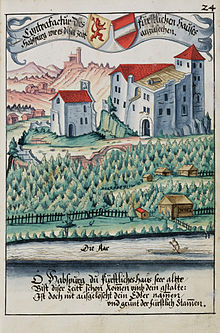
View of the Habsburg by Hans Ulrich Fisch, 1634.

Coat of arms of the Habsburgs (in the Zurich coat of arms around 1340)
Habsburg as the House of Austria (Casa de Austria)
House of Austria (Latin domus Austriae, Spanish Casa de Austria, French Maison d'Autriche, Italian Casa d'Austria) is a designation of both the Habsburg house power (the territories of the Habsburg Monarchy, especially the hereditary lands) and the entire noble family in the Austrian and Spanish lines and their collateral lines.
The term House of Austria has its origin in the Latin expression domus Austriae. It can be traced back to 1326 for the first time, and from the first half of the 15th century it became established as a common designation in German as well. With the founding of the Austrian Empire in 1804, the term lost its meaning.
Habsburg Monarchy (also Habsburg Empire) was the unofficial designation for the entire dominions of the Habsburg dynasty in Europe ruled in personal union in modern times until 1918 (usually excluding the lands of the Spanish Habsburgs), i.e. its hereditary lands, which were hereditary to the house, and the respective elected offices.
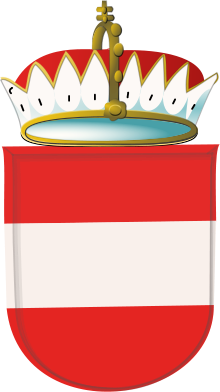
House coat of arms crowned with the archducal hat, 1512
History
Early Habsburgs according to the Acta Murensia (until 1279)
The early generations of the Habsburgs can be reconstructed on the one hand on the basis of genealogical records, which had already been drawn up in 1160, and on the other hand on the basis of the will of Werner I (1030-1096). Whereby the will is dated to 1027, but was probably written around 1085. Habsburg genealogists such as Albrecht von Bonstetten or Jakob Mennel worked out complete family trees of their lineage already around 1500. These early genealogies list, among others, Roman nobles, Priam of Troy (son of Jupiter) and King Arthur as direct ancestors. This was a quite common method (as an example the Zimmerian Chronicle is mentioned where Count Froben also refers to ancient ancestors). Historically founded results about these early family tree relations are not available. Only the names can be proved.
The Etichone Guntram the Rich († 973) is supposed to be the progenitor according to the genealogical trees of the Acta Murensia compiled in 1160. Another source mentions a Guntram who is said to have been a count on the Upper Rhine.
Around 1027 Radbot (985-1045) founded together with his wife Ita of Lorraine (995-1035) the Benedictine monastery of Muri, his brother Rudolf (985/990- around 1063) the monastery of Ottmarsheim located in the Upper Alsace. Around 1020, Radbot or Werner I (1030-1096) built Habsburg Castle, which is located in the Swiss municipality of the same name. The Habsburgs had also built other castles. Otto, Count of Habsburg († 1111) was the first of the family to call himself von Habsburg. In the 11th and 12th centuries the Habsburgs expanded their territories. They acquired bailiwicks and county rights. They thus became landgraves in Upper Alsace (Sundgau) and bailiffs of the Strasbourg High Chapter and claimed the inheritance of the Counts of Kyburg, so that they took possession of lands in the Zürichgau, Schwyz, Unterwalden, Aargau, Frickgau and Uri; these territories were later called Stammlande.
The first house division took place in the early 13th century. Albrecht IV was the founder of the older line and Rudolf III of the Habsburg-Laufenburg line. The competition created a spatial separation. Although Rudolf III was not condemned to a secondary role, he did not succeed in establishing his own ruling center in central Switzerland. Later attempts were often thwarted by the older line.
Albrecht's son Rudolf IV, on the other hand, was able to systematically expand his empire. He succeeded in extending his dominion to the Black Forest. Through the Kyburg inheritance, he was also able to claim eastern and northeastern Switzerland for himself. Thus he became a powerful lord of the Upper Rhine. His election as Roman-German king in 1273 as Rudolf I crowned his success.
The death of King Ottokar II in 1278 and the seizure of the duchies he occupied marked the beginning of Habsburg rule in Austria (more precisely, in what is now Lower and Upper Austria, as well as Styria).
The Habsburg claim to dominion
After the election of Rudolf I as Roman-German king, the Habsburgs established a significant domestic power with the acquisition of the duchies of Austria and Styria (by enfeoffment of Rudolf's sons). With further territorial gains in the east and the loss of the Old Habsburg possessions in Switzerland as a result of the Swiss-Habsburg Wars in the 14th and 15th centuries, the center of power finally shifted to the eastern Alpine region. The Habsburg itself fell to the Confederates in 1415. Nevertheless, the Habsburgs' relations with their former heartland remained close. This was evident, among other things, in the Muri monastery and Königsfelden Abbey, and most recently in the decades-long stay of the last empress, Zita, in Switzerland.
The failure to include him in the circle of electors in the Golden Bull prompted Duke Rudolf IV to issue a forgery in 1358 / 1359, the Privilegium Maius, in which he claimed the title of archduke, which later became characteristic of the Habsburgs. However, the Italian scholar Francesco Petrarca already came to the conclusion that the documents had been forged. The Privilegium Maius was only confirmed by the Habsburg Emperor Frederick III in 1453 and recognized under imperial law.
The Habsburg dynasty demanded an almost sacred place for itself in society and in the structure of the empire, combined with a claim to the imperial crown. The motto A.E.I.O.U., introduced by Emperor Frederick III, is an expression of this mentality. Its interpretation has given rise to manifold speculations, but it is probably to be understood as Austriae est imperare orbi universo ("Austria is destined to rule the world") or as the royal-judicial motto amor electis iniustis ordinor ultor ("love rules over the elect, the avenger over the unjust"). The Pietas Austriaca of the Archbishopric, which also loved to call itself the Casa d'Austria and thus reaffirmed its claim to power in Spain and Italy, is impressively expressed on the Plague Column, dedicated to the Trinity by Emperor Leopold I in 1679 and erected in Vienna. On its three sides, representing the Trinity of God, are the coats of arms and crowns of Austria, Bohemia and Hungary, although Austria, significantly, wears the imperial crown rather than the ducal hat. Huge stone scrolls held by angels explain the Habsburg state program to the viewer: Austria with the imperial crown is assigned to the Deo Patri Creatori, Bohemia with the Wenceslas crown to the Deo Filio Redemptori, and Hungary with the St. Stephen crown to the Deo Spiritui Sanctificatori. On earth, the three main Habsburg lands correspond to the heavenly Trinity - each independent, but united in an indissoluble unity, for the salvation of the earth's circle. The burial place of the Habsburgs in the Capuchin crypt in Vienna underscores the sacral character of the archbishopric.
The Habsburgs as rulers of the Holy Roman Empire
Since the election of King Albrecht II in 1438, the Habsburgs - with the exception of Emperor Charles VII (1742-1745) - provided all emperors of the Holy Roman Empire until its end in 1806. (1742-1745) - all emperors of the Holy Roman Empire until its end in 1806.
With the help of their marriage policy, the Habsburgs acquired the Burgundian Netherlands, the Free County of Burgundy and then the crowns of Spain, Bohemia, Croatia and Hungary (Habsburg Monarchy) through Maximilian I in the late 15th century. With the Bohemian crown, the electorship and thus the vote of the highest-ranking secular member among the seven electors finally fell to the Habsburgs in 1526 (for the ranking, see Elector).
With the successors of Emperor Charles V, the Habsburgs divided into a Spanish and an Austrian line. After the extinction of the Spanish line with Charles II in 1700, the Austrian Habsburgs were able to win only a small part of the Spanish inheritance in the War of the Spanish Succession.
In 1740, the Austrian line also died out in the male line. By the Pragmatic Sanction of 1713, Charles VI had secured the right of succession of female descendants for this case, whereby his daughter Maria Theresa assumed the rights of ruler. After her marriage to Franz Stephan of Lorraine, the dynasty called itself Habsburg-Lorraine. It provided the emperors of the Holy Roman Empire of the German Nation from 1765 to 1806 after the death of Emperor Francis I Stephen.
In 1806, as a result of the Napoleonic Wars, Emperor Francis II abdicated the crown; the Holy Roman Empire was thus de facto extinct.
Austrian Empire
Even before that, in 1804, Emperor Franz II had proclaimed the hereditary Empire of Austria as Franz I in order to maintain equality of rank with Napoleon, who had been proclaimed Emperor of the French in the same year. The Austrian Empire comprised all Habsburg hereditary lands. In 1867 it was transformed into the Austro-Hungarian Monarchy, which disintegrated at the end of the First World War in 1918.
In the new Empire of Austria, the private crown of the House of Habsburg, made by order of Emperor Rudolf II in Prague in 1602, was declared the official Austrian imperial crown, but a coronation as Emperor of Austria never took place. However, Francis I had himself painted wearing the crown. On the other hand, all Austrian emperors - Francis I (1804-1835), Ferdinand I (V) (1835-1848), Franz Joseph I (1848-1916) and Charles I (IV) (1916-1918) - were crowned Hungarian kings with the Crown of St. Stephen in order to comply with Hungarian state law; Franz Joseph, of course, only in 1867, after an almost twenty-year struggle with the Hungarian estates. The coronation with the Bohemian crown of Wenceslas took place for the last time in 1836 for Ferdinand I(V). He was also the only Austrian emperor crowned (in 1838) with the Iron Crown of Lombardy.
Habsburgs after 1918
On November 11, 1918, Emperor Charles I renounced any share in the affairs of state on behalf of German Austria, and on November 13, also as King Charles IV of Hungary. Since Charles did not formally abdicate, any reference to the then 6-year-old Crown Prince Otto could be omitted - in contrast to the German Empire. The other parts of the Dual Monarchy, dissolved by Hungary on October 31, 1918, by the termination of the Real Union, made themselves independent of the ruling house without contact with Charles. He moved with his family to Switzerland in March 1919 to escape internment in Austria.
The Habsburg Law of German Austria of 3 April 1919 expelled Karl permanently from the country, and all other members of the Habsburg-Lothringen family as long as they had not officially renounced their affiliation to the House of Habsburg-Lothringen (i.e. to the dynasty with its claims to power) and declared themselves faithful citizens of the Republic. In addition, the Habsburg family funds were expropriated (but not demonstrably personal private property). The members of the house opted partly for republican Austria and partly for life outside the new republic. Until the 2010 federal presidential election, members of ruling houses or of such families that had formerly ruled were excluded from eligibility for election to the federal presidency ("passive suffrage") in Austria pursuant to the Federal Constitution Act 1920 with Art. 60 para. 3, 2nd sentence, most recently in the version of July 1, 2007. It was not until June 16, 2011, that the Habsburg Clause was repealed by the Austrian National Council as part of the 2011 Electoral Law Amendment Act and entered into force in its new version (Art. 60 B-VG) on October 1, 2011.
After two failed attempts to restore King Charles IV to Hungary from Switzerland in 1921, the Hungarian Parliament decided to dethrone the House of Habsburg-Lorraine on November 6, 1921. Hungary remained a kingdom without a king under the imperial administrator Miklós Horthy. Charles was exiled from Hungary to Madeira by the Allies after the second restoration attempt, where he died in 1922 after a serious illness. His widow Zita was not allowed to re-enter Austria until 1982.
During the interwar period and World War II, the Habsburg-Lothringen family made efforts to treat Austria as a victim state and helped many persecuted persons to escape. The head of the family from 1930 to 2006 was Otto Habsburg-Lothringen (1912-2011), the eldest son of Emperor Karl. He did not sign the declaration of renunciation required by the Republic of Austria under the Habsburg Law until 1961. Under his aegis, the primary fields of occupation of many members of the family (including, above all, Karl, Georg, as well as Walburga) shifted to European policy, especially that of the Pan-European Union, with whose founder, Richard Coudenhove-Kalergi, Otto Habsburg was a friend.
Since 2004, Austria has had the Black-Yellow Alliance, a party that advocates the restoration of the monarchy under the Habsburgs.
On January 1, 2007, Otto Habsburg-Lothringen transferred the function as head of the family to his eldest son Karl.
In 2011, the Order of St. George - A European Order of the House of Habsburg-Lorraine was (re)established by Charles Habsburg-Lorraine as an Order of the House of Habsburg.
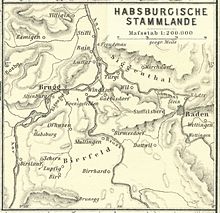
Habsburg ancestral lands (map from 1879)
_-_Crypt_-_Speyer_Cathedral_-_Speyer_-_Germany_2017.jpg)
Rudolf I, from 1273 the first Roman-German king from the House of Habsburg, established the supraregional importance of his dynasty
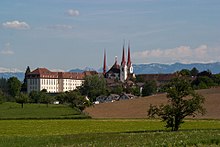
Muri Monastery, Switzerland (Canton Aargau): founded by the Counts of Habsburg (1027)

Emperor Maximilian I laid the foundation for the power of the House of Austria with his European Habsburg marriage policy

Habsburg dominion before the partition of 1556 in the Old World
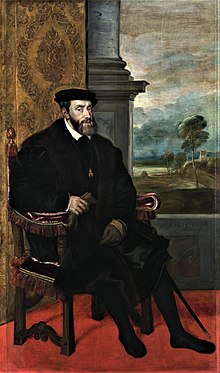
Emperor Charles V (1500-1558) led the power of the House of Habsburg to its peak

Empress Maria Theresa (1717-1780) was the heiress of the Habsburgs. Since her marriage to Francis Stephen of Lorraine, the House of Habsburg called itself Lorraine.

Charles I was the last emperor of Austria (1887-1922)
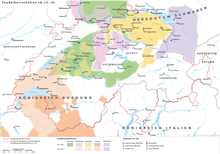
Territorial claims of the Habsburgs around 1200
The coat of arms of the Habsburgs
Development until 1804
The old ancestral coat of arms of the Counts of Habsburg showed in gold a red, blue-armed and blue-crowned lion. On the helmet with red-golden covers the lion growing, behind with a notched red umbrella board trimmed with peacock feathers. The lion appears in old representations also uncrowned, and the rear umbrella board of the crest also silver, as seen in the Zurich roll of arms, the umbrella board was (rarely) but also golden depicted.
The lion coat of arms can still be found in numerous municipal and town coats of arms of the former Habsburg territories, especially in Vorderösterreich - for example Rheinfelden (Baden), Bremgarten AG, Laufenburg AG, Laufenburg (Baden), Bonndorf, Bräunlingen and Wislikofen, the town of Waldshut received it as an honorary coat of arms in 1468. In Munderkingen it is shown together with a star, in Veringenstadt and Gammertingen together with the stag of Württemberg. While Sempach still shows the old coat of arms with the lion, Sursee has changed to a twisted, simplified shield coat of arms of the dukes of Austria. The coat of arms of Kriessern shows a lying lion holding the imperial orb in its paws as a reference to the former imperial court of Kriessern.
When the Habsburgs became dukes of Austria in 1282, they also adopted the red-white-red national coat of arms, the Bindenschild, which in subsequent years increasingly became the dynasty's actual coat of arms. As early as 1325, King Frederick (III) the Fair placed the banded shield on the breast of the imperial eagle. The old coat of arms of the Counts of Habsburg, on the other hand, receded more and more into the background.
The coat of arms of Emperor Rudolf II shows on the breast of the imperial eagle a simply divided shield, which shows heraldically on the right (thus on the left as seen from the viewer) the shield of the bandage for Austria, and heraldically on the left (on the right as seen from the viewer) the coat of arms of Castile. Maria Theresa had in the center of her coat of arms only a red-white-red heart shield, which now finally no longer stood for a concrete territory, but was to be understood in a dynastic sense. Her son Joseph II, with whom the rule of the House of Habsburg-Lorraine began, split his heart shield, which "must now consist of the Austrian and Lorraine coats of arms"; his brother and successor Leopold II added that of Tuscany to these two fields, so that the heart shield now contained three fields.
· 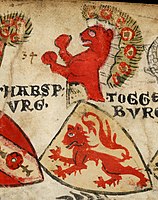
Coat of arms of the Habsburgs in the Zurich Roll of Arms around 1340
· 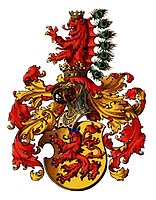
Coat of arms of the Habsburgs in Renaissance style from the coat of arms roll of Austria-Hungary by Hugo Gerhard Ströhl, Vienna 1890, plate II.
· 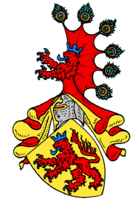
Coat of arms of the Habsburgs, modern representation after old coat of arms images
· 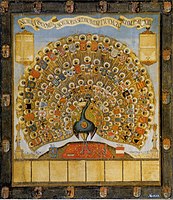
"Habsburg peacock" with the coats of arms of the dominions of the House of Habsburg, 1555
· 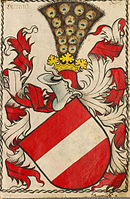
Austria under the peacock bump. Scheibler's coat of arms book, older part
The coat of arms since the proclamation of the Austrian Empire
The proclamation of the Austrian Empire in 1804 and the end of the Holy Roman Empire in 1806 led to a series of changes in the title and coat of arms of the Habsburgs. In 1804, it was still declared that the "current coat of arms of the Most Serene House of Austria" was a "silver crossbar in a red field", i.e. the red-white-red shield.
In 1806, however, the heart shield acquires its definitive form: The shield is split twice (vertically) and contains in the heraldic right field the old Habsburg coat of arms (the red, blue-crowned lion on a golden background), in the heraldic left field the coat of arms of Lorraine (three silver, muzzled eagles on a slanting red bar in a golden background), in the center the Austrian house coat of arms (a silver crossbar on a red background). Together this coat of arms is called "the genealogical coat of arms of the Most Sublime Reigning Imperial House".
The small coat of arms of Austria-Hungary from November 1915 to October 1918 was intended for use in the common institutions of the Austro-Hungarian monarchy. Heraldically, it shows the Austrian double-headed eagle on the right (i.e. as seen from the shield bearer), and the Hungarian coat of arms on the left. The two shields are surmounted by the coat of arms of the House of Habsburg-Lorraine: Heraldically on the right in gold a blue-crowned red lion (Habsburg), in the red center field a silver crossbeam (Austria), heraldically on the left in gold a red slanting beam with three muted silver eagles (Lorraine). It is crowned with a royal crown and decorated with the Order of the Golden Fleece (Toison d'or). The separation of the Habsburg house coat of arms and the double eagle only occurred in the course of the last coat of arms reform in 1915 to accommodate the Hungarians, for whom the double eagle represented a reminder that Austria had attempted to incorporate Hungary into a unitary state until 1866. The double-headed eagle is therefore now only radicated with the Empire of Austria - by which Cisleithania is to be understood - and juxtaposed with the royal Hungarian coat of arms, which has equal status. Both escutcheons are connected by a smaller escutcheon surmounting them with the genealogical coat of arms of the Habsburgs. The war prevented the continuous introduction of the new symbol of the Dual Monarchy until its dissolution in 1918.

"The Genealogical Coat of Arms of the Most Sublime Reigning Imperial House", from 1806 onwards
Lists of persons
Genealogy
- Habsburg family tree
- Master list of the House of Habsburg-Lorraine
- Habsburg-Laufenburg and Neu-Kyburg, collateral lines of the 13th to 15th centuries
Roman-German Emperors and Kings from the House of Habsburg
- Rudolf I, King 1273-1291
- Albrecht I, King 1298-1308
- Frederick the Fair, counter-king 1314-1330
- Albrecht II, King 1438-1439
- Frederick III, King 1440-1486, Emperor 1452-1493
- Maximilian I, King 1486, Emperor 1508-1519
- Charles V. , King 1519, Emperor 1520-1556 (abdicated), † 1558
- Ferdinand I, King 1531, Emperor 1558-1564
- Maximilian II, King 1562, Emperor 1564-1576
- Rudolf II. , King 1575, Emperor 1576-1612
- Matthias, King and Emperor 1612, † 1619
- Ferdinand II, King and Emperor 1619-1637
- Ferdinand III, King 1636, Emperor 1637-1657
- Ferdinand IV, King 1653-1654
- Leopold I, King and Emperor 1658-1705
- Joseph I, King 1690, Emperor 1705-1711
- Charles VI. King & Emperor 1711-1740
Roman-German Emperors and Kings from the House of Habsburg-Lorraine
- (Francis I Stephen, King & Emperor 1745-1765 House of Lorraine)
- Joseph II, King 1764, Emperor 1765-1790
- Leopold II, King and Emperor 1790-1792
- Francis II. , King and Emperor 1792-1806 (empire extinct, crown laid down), † 1835
Emperor of Austria from the House of Habsburg-Lorraine
→ Main article: Emperor of Austria
- Francis I. , Emperor 1804-1835
- Ferdinand I, Emperor 1835-1848 (relinquished government, retained title), † 1875
- Franz Joseph I, Emperor 1848-1916
- Charles I Emperor 1916-1918 (1918 renunciation of any share in the affairs of state, proclamation of the Republic, exile without abdication), † 1922
Heads of families since 1918
- Karl until 1922
- Otto von Habsburg 1922-2006 (until coming of age in 1930 with mother Zita)
- Karl Habsburg-Lorraine since 2007
Emperor of Mexico from the House of Habsburg-Lorraine
- Maximilian I 1864-1867
Kings of Spain and Portugal from the House of Habsburg (Casa de Austria)
See also Spain under the Habsburgs
- Philip I 1504-1506 (King of Castile)
- Charles I 1516-1556
- Philip II. (in Portugal: Philip I) 1556/1580-1598
- Philip III. (in Portugal: Philip II) 1598-1621
- Philip IV. (in Portugal: Philip III) 1621-1640/1665
- Charles II 1665-1700
Kings of Bohemia and Hungary from the Houses of Habsburg and Habsburg-Lorraine
- Rudolf I (only King of Bohemia) 1306-1307
- Albrecht (as Roman-German king: Albrecht II) 1438-1439
- Ladislaus V Postumus 1440-1457
- Ferdinand I. (Roman-Dutch Emperor Ferdinand I) 1527-1564
- Maximilian (Roman Emperor Maximilian II) 1564-1576
- Rudolf (Roman-Dutch Emperor Rudolf II) 1576-1608
- Matthias II (Roman-Dutch Emperor Matthias) 1608-1619
- Ferdinand II. (Roman-Dutch Emperor Ferdinand II) 1619-1637
- Ferdinand III. (Roman-Dutch Emperor Ferdinand III) 1637-1657
- Ferdinand IV (Roman-Dutch king (= heir to the throne) Ferdinand IV)
- Leopold I. (Roman-Dutch Emperor Leopold I) 1657-1705
- Joseph I (Roman Emperor Joseph I) 1705-1711
- Charles II. (Bohemia) / III. (Hungary) (Roman-Dutch Emperor Charles VI) 1711-1740
- Maria Theresa (Rex Bohemiae, Rex Hungariae) 1740-1780
- Joseph II (Roman Emperor Joseph II) 1780-1790
- Leopold II. (Roman-Dutch Emperor Leopold II) 1790-1792
- Francis I (Emperor Francis I of Austria) 1792-1835
- Ferdinand V. (Emperor Ferdinand I of Austria) 1835-1848
- Franz Joseph I (Emperor Franz Joseph I of Austria) 1848-1916
- Charles III. (Bohemia) / IV. (Hungary) (Emperor Charles I of Austria) 1916-1918
Sovereigns of Austria from the Houses of Habsburg and Habsburg-Lorraine
see in addition:
- List of Margraves and Dukes of Austria in the Middle Ages 871-1457/1463
- List of Archdukes of Austria 1457/1463-1918
- Lists of the Habsburg collateral lines:
- List of the rulers of Inner Austria (Styria, Carinthia, Carniola and Coastal Lands) 1379/1411-1457 (Albertines and Leopoldines) and 1564-1619
- List of the rulers of Tyrol 1363-1490 and 1564-1665 (older and younger Tyrolean line)
Sovereigns and governors of the Burgundian State and the Netherlands from the Houses of Habsburg and Habsburg-Lorraine respectively
- Philip IV. (King Philip I of Castile) 1482-1506
- Charles II. (Roman-Dutch Emperor Charles V) 1506-1555 (governors among others Margaret of Austria 1507-1530; Mary of Hungary 1531-1555)
- Philip V (King Philip II of Spain) 1555-1598 (governors included Margaret of Parma 1559-1567; Juan de Austria 1576-1578; Ernst of Austria 1594-1595; Albrecht VII of Habsburg 1596-1598)
- Albrecht VII of Habsburg and Isabella of Spain, 1598-1621
- Philip VI. (King Philip IV of Spain) 1621-1665 (governors included Isabella of Spain 1621-1633; Ferdinand of Spain 1633-1641; Leopold William of Austria 1647-1656; Juan José de Austria 1656-1659)
- Charles III. (King Charles II of Spain) 1665-1700
- Charles IV (Roman-Dutch Emperor Charles VI) 1700/14-1740 (governor among others Maria Elisabeth of Austria 1724-1741)
- Maria Theresa (Maria Theresa v. Austria) 1740-1780 (governor a. Maria Anna of Austria 1744)
- Joseph (Roman-Dutch Emperor Joseph II) 1780-1790 (governor a. Marie Christine of Austria 1781-1793)
- Leopold (Roman-Dutch Emperor Leopold II) 1790-1792
- Franz (Roman Emperor Franz II) 1793-1794 (Governor a. Karl von Österreich-Teschen 1793-1794)
Grand Dukes of Tuscany from the House of Habsburg-Lorraine
- Francis Stephen of Lorraine (Roman Emperor Francis I) 1737-1765
- Leopold I. (Roman-Dutch Emperor Leopold II) 1765-1790
- Ferdinand III 1790-1800, again 1814-1824
- Leopold II 1824-1849, again 1849-1859
- Ferdinand IV 1859-1860 (annexation to the Kingdom of Sardinia)
Dukes of Modena from the House of Habsburg-Lorraine and Austria-Este respectively
- Francis IV 1814-1846
- Francis V 1846-1848, 1849-1859
Duchess of Parma from the House of Habsburg-Lorraine
- Marie-Louise 1814-1847
Reichsverweser of the German Empire (1848-1849) from the House of Habsburg-Lorraine
- John 1848-1849
More
- List of Roman-German rulers
- List of rulers of Croatia
- List of rulers of Hungary
- List of Moravian rulers
- List of Bohemian rulers
- List of the heads of state of Spain
- List of rulers of Tuscany
- List of the rulers of Parma
- List of Grand Masters of the Teutonic Order
- List of palatines of Hungary
See also
- Austrian imperial anthems
- Habsburg lip
- Asteroid (85199) Habsburg was named after the House of Habsburg
- Imperial Austrian Family Statute 1839
- The Habsburgs in Alsace
- Tombs of the Habsburgs
Search within the encyclopedia